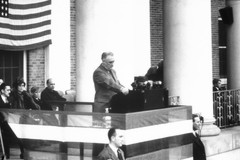The storied history of medical hematology and oncology fellows at the National Institutes of Health (NIH) dates back more than 80 years. The over 600 physician researchers who have worked and trained at the National Cancer Institute (NCI) and the National Heart Lung and Blood Institute (NHLBI) include giants of the field. Over the years, our alumni have improved the lives of millions of cancer patients.
On October 31, 1940, President Franklin D. Roosevelt stood on the steps of Building 1 and delivered a speech dedicating the new Bethesda campus of the National Institute of Health, including the building for the new National Cancer Institute.

Attracting “the most brilliant and promising research fellows from the United States or abroad” was a stated aim of the 1937 act establishing the NCI. A year later, the first bright young physician-scientists intent on investigating and treating the nation’s growing incidence of cancer were appointed as fellows. The institute’s state-of-the-art laboratory opened in Bethesda, Md., the following year on a former estate that recently had been donated to the government to house the NIH.
Notable early fellows
After completing their fellowships, many of our alumni have stayed on and contributed to the NCI’s myriad accomplishments as well as those of the NHLBI. A notable early fellow was Henry Seymour Kaplan, M.D., who trained here in the early 1940s. He went on to Stanford University, where he co-developed the medical linear accelerator for cancer treatment. This led to one of the major treatment advances of the 20th century, extended field radiation treatment for Hodgkin lymphoma.
The opening of the Clinical Center on the expanding NIH campus in 1953 facilitated the integration of laboratory and clinical research to improve patient care. A few years later, ground-breaking NCI physician researchers Gordon Zubrod, M.D., Emil “Tom” Frei III, M.D. and Emil J. Freireich, M.D. came to NCI. Their presence ushered in an era of progress towards eradicating cancer detailed in the widely acclaimed book, The Emperor of All Maladies by oncologist Siddhartha Mukherjee, M.D., D.Phil.
The 1960s saw the arrival of Vincent DeVita, M.D. (now the Amy and Joseph Perella Professor of Medicine at the Yale Cancer Center), who arrived in 1963 and worked with Frei and Freireich during his fellowship. Dr. DeVita returned to NCI in 1966 as a senior investigator, and collaborated with another fellow, George Canellos, M.D. (now the William Rosenberg Professor of Medicine, Emeritus, at the Harvard Medical School) to develop MOPP, the first successful combination chemotherapy program. Used to treat Hodgkin lymphoma and diffuse large B-cell lymphomas, MOPP reduced the likelihood of dying from Hodgkin lymphoma from nearly 100% to around 30%.
Dr. DeVita established the basis for further combination therapies, which became a mainstay of cancer treatment. In 1980, he was appointed director of the NCI, a position he held until 1988. While at NCI, he served as one of the editors for the first edition of CANCER: Principles & Practices of Oncology. Now in its 11th edition, CANCER is the most widely-read text on cancer in the world. Collaborations between Drs. Canellos and DaVita also resulted the combination chemotherapy CMF, which remains a useful therapy for breast cancer.
Bruce Chabner, M.D. (now chief of hematology and oncology at the Massachusetts General Hospital) is another prominent cancer researcher who served as an NCI medical oncology fellow. He arrived in 1967 and stayed on at the NCI after completing his fellowship in 1969, where his research led to the development of Taxol, a commonly prescribed drug to treat breast, ovary, lung and other cancers. In 1983, he became the director of the NCI’s division of Cancer Treatment.
A place where many leaders began their careers
“The NCI fellowship has afforded a unique combination of opportunities for excellent clinical training and translational research experience,” Dr. Chabner says. “Many of the leaders in translational research began their careers at the NCI and flourished in this outstanding environment.”
The NCI’s formal Medical Oncology Fellowship program officially began in 1982, while Dr. DeVita was the NCI director. It was officially accredited by the Accreditation Council for Graduate Medical Education in 1991.
The NHLBI’s Hematology Fellowship Program began in 1991 under the leadership of Cynthia Dunbar, M.D., whose basic laboratory research on stem cells led to the first FDA-approved drug for treating aplastic anemia in more than 30 years.
The Medical Oncology Fellowship and Hematology Fellowship programs officially joined together to create the NIH Hematology Oncology Fellowship Program in 2016.
Former Directors of the NIH Hematology Oncology Fellowship Program
2018-2021: Marijo Bilusic, M.D., Ph.D. (alumnus of the program)
2016-2018: Charles Bolan, M.D.
Former Directors of the Medical Oncology Fellowship Program
2015-2016: James Gulley, M.D., Ph.D. (alumnus of the program)
2007-2015: Antonio “Tito” Fojo, M.D., Ph.D. (alumnus of the program)
2001-2007: Barry Gause, M.D. (alumnus of the program)
1995-2007: Michael Hamilton, M.D.
1993-1995: Carmen Allegra, M.D. (alumnus of the program)
1990-1993: Robert Wittes, M.D.
1987-1990: Charles Myers, M.D. (alumnus of the program)
1982-1987: Robert Young, M.D. (alumnus of the program)
Former Directors of the Hematology Fellowship Program
2008-2016: Charles Bolan, M.D.
1991-2008: Cynthia Dunbar, M.D.